Australia’s world-envied superannuation scheme paused for breath through the COVID 19 pandemic, as it did during the 2008-09 GFC, but is now making up most of the lost ground in 2021. Assets’ growth over the 10 years to end 2021 will have averaged just on 7 per cent per annum, due to membership contributions and wealth creation (less retiree withdrawals in our ageing society), as we see below. The coffers now have over $3 trillion in assets for members.
Superannuation Growth
Including unfunded 1988-2020(E)

Source: RBA/Ruthven Institute 12/01/21
One of the industry’s many challenges is maintaining-the-rage, so to speak, that the then Prime Minister Paul Keating started nearly three decades ago. While the goal of a scheme to see 12 or even 15 per cent of wages invested for an adequate and dignified environment was not world-breaking (Singapore was way higher), it is disturbing to think there is even debate federally about a rise to 10 per cent this year, and a question hanging over the 12 per cent goal in size and/or timing later in this new decade.
Some perspective is important in policy-setting and investment decisions going forward from the pandemic interruption and an accompanying tendency to regress to short term thinking.
So, it is interesting to note that:
- the original goal of a net margin of wealth creation of 3.5 per cent over inflation has been bettered easily over the past decade (closer to 5 per cent per annum by the leading performing super funds)
- super funds are now 26.7 per cent of average household net worth (compared to 23.5 per cent in 2010)
- housing assets, net of mortgage liabilities, and being passive assets at that, are now down from 38 per cent of household net worth in 2010 to 34 per cent in 2020, and can one day be surpassed by the more active wealth creating asset (super)
- disturbingly, Australia has one of the highest levels of mortgage debt in the world at over 120 per cent of GDP, and likely to grow with our record low mortgage rates (around 3 per cent), with governments seeing housing and rising mortgages as recession-busting and a stamp-duty collecting bonanza for state governments
- some super funds are leading the charge to better returns via better asset class weighting and better selection of products and stocks within those classes, and an international view of the choices rather than being handcuffed to the Australia-only marketplace
- super funds are starting to talk seriously to under-performing listed stocks and asking for better performance and profitability (for their members), due to the fact that only one in ten of our listed stocks regularly achieve world’s best practice returns of 22 per cent Return on Shareholder Funds (ROSFompared with four in ten US stocks, and that lower performance not being due to population size or hi-tech stocks (as distinct from unique IP in any industry)
- more economies-of-scale and sophistication are emerging with the reduction in the number of funds (from 550 in 2007 to 250 bigger ones in 2021)
- some of the bigger funds are intending to reverse the outsourcing of funds management (DIFM) and bring much of the funds management in-house (DIY) for a reduction in fees (benefiting members if profitability is maintained or improved) on a DIY basis
- there are currently four somewhat similar sized-fund groups – industry, retail, small (including SMSFs) and the public sector, with industry funds seemingly the front runners, as the retail funds and SMSFs growth are slowing, and
- the popularity of SMSFs appears to be plateauing with the capping of super fund size, and the improving performance/profitability of the better managed big funds.
These are all signs of a vibrant and changing industry for the better.
So, what are the hurdles the industry needs to jump-over or crash-through post-COVID 19? Some of them seem to be:
- a need to educate and/or sell-to younger generations—Millennials and the Gen Zers—the importance of superannuation, given that these generations are at ages where they often believe they will never get sick, don’t think about retirement, and will never die
- the continuing challenge of financial literacy for the population that has achieved some measure of economic literacy over recent decades
- encouraging politicians into thinking longer than a year or the next election, given that we did so well in the nation’s 19th century when we planned by generational lengths and grew the economy at a staggering 8 per cent per annum (real) for that century; and as our Asian neighbours still do now in the 21st century
- keep stretching the boundaries on investment, asset classes, product and stock selection to lift the growth even further above the 6.4 per cent average of the past decade.
After all, superannuation is a good cause, a vital component of nation-building and is improving our standard of living. And retiring.
Phil Ruthven AM, founder & CEO Ruthven Institute




































